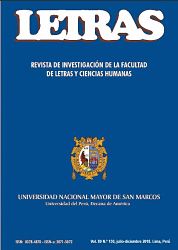The modernizing myth in the novel El zorro de arriba y el zorro de abajo by José María Arguedas
DOI:
https://doi.org/10.30920/letras.89.130.7Keywords:
El zorro de arriba y el zorro de abajo, José María Arguedas, Myth, Modern novel, Latin American BoomAbstract
The function of myth, as a modernizing mechanism in the novel, may seem a contradiction, since it has been traditionally linked, mainly, to archaic thought, to the worldview model of the first civilizations. For that reason, this concept or category would oppose the modernizing function of a novel in the context of "El boom latinoamericano". In this article, we are interested in arguing how José María Arguedas, in his latest novel El zorro de arriba y el zorro de abajo, uses some clichés of the myth to structure a proposal for a modern novel, such as the intertextual character, the dialogue, the timeless character, the sacrificial rite and the binary character. This audacious strategy corresponds to a logic linked to its poetic claim to indigenous culture. In this sense, you can design a proposal even more ambitious than that of the Boom writers, because not only do you experience the formats of the novel in the Western style, but you also assume a cultural element of your own to build your poetics. A task that the members of the Boom could not perform.







